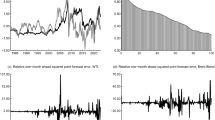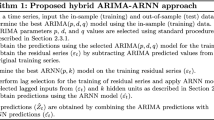Abstract
We propose a mean-reverting interest rate model whose mean-reverting level, speed of mean-reversion and volatility are all modulated by a weak Markov chain (WMC). This model features a simple way to capture the regime-switching evolution of the parameters as well as the memory property of the data. Concentrating on the second-order WMC framework, we derive the filters of the WMC and other auxiliary processes through a change of reference probability measure. Optimal estimates of model parameters are provided by employing the EM algorithm. The \(h\)-step ahead forecasts under our proposed set-up are examined and compared with those under the usual Markovian regime-switching framework. We obtain better goodness-of-fit performance based on our numerical results generated from the implementation of WMC-based filters to a 10-year dataset of weekly short-term-maturity Canadian yield rates. Some statistical inference issues of the proposed modelling approach are also discussed.





Similar content being viewed by others
References
Abry, P., & Veitch, D. (1998). Wavelet analysis of long-range-dependent traffic. IEEE Transaction on Information Theory, 44(1), 2–15.
Audrino, F., & Medeiros, M. (2011). Modelling and forecasting short-term interest rates: The benefits of smooth regimes, macroeconomic variables and bagging. Journal of Applied Econometrics, 26(6), 999–1022.
Bouchaud, J., & Potters, M. (2004). Theory of financial risk and derivative pricing: From statistical physics to risk management. Cambridge: Cambridge University Press.
Cajueiro, D., & Tabak, B. (2007). Long-range dependence and multifractality in the term structure of LIBOR interest rates. Physica A (Statistical Mechanics and Its Applications), 373, 603–614.
Cajueiro, D., & Tabak, B. (2007). Time-varying long-range dependence in US interest rates. Chaos Solitons and Fractals, 34, 360–367.
Chapman, D., Long, J., & Pearson, N. (1999). Using proxies for the short rate: When are three months like an instant? Review of Financial Studies, 12, 763–806.
Ching, W., Siu, T., & Li, L. (2007). Pricing exotic options under a higher-order hidden Markov model. Journal of Applied Mathematics and Decision Sciences, 18014, 1–15.
Cox, J., Ingersoll, J., & Ross, S. (1985). A theory of the term structure of interest rates. Econometrica, 53(2), 385–407.
Dajcman, S. (2012). Time-varying long-range dependence in stock market returns and financial market disruptions—a case of eight European countries. Applied Economics Letters, 19, 953–957.
Duan, J., & Jacobs, K. (1996). A simple long-memory equilibrium interest rate model. Economics Letters, 53(3), 317–321.
Elliott, R., Hunter, W., & Jamieson, B. (2001). Financial signal processing: A self-calibrating model. International Journal of Theoretical and Applied Finance, 4, 567–584.
Elliott, R., & Mamon, R. (2002). An interest rate model with a Markovian mean-reverting level. Quantitative Finance, 2, 454–458.
Elliott, R., Moore, J., & Aggoun, L. (1995). Hidden Markov models: Estimation and control. New York: Springer.
Erlwein, C., & Mamon, R. (2009). An online estimation scheme for a Hull–White model with HMM-driven parameters. Statistical Methods and Applications, 18(1), 87–107.
Erlwein, C., Mamon, R., & Davison, M. (2011). An examination of HMM-based investment strategies for asset allocation. Applied Stochastic Models in Business and Industry, 27, 204–221.
Filipović, D. (2009). Term structure models. Heidelberg: Springer.
Garthwaite, P., Jolliffe, I., & Jones, B. (2002). Statistical inference (2nd ed.). Oxford: Oxford Science Publication.
Guidolin, M., & Timmermann, A. (2009). Forecasts of US short-term interest rates: A flexible forecast combination approach. Journal of Econometrics, 150(2), 297–311.
Hamilton, J. (1989). A new approach to the economic analysis of nonstationary time series and the business cycle. Econometrica, 57(2), 357–84.
Hardy, M. (2001). A regime-switching model of long-term stock returns. North American Actuarial Journal, 5(2), 41–53.
Holmes, M., Dutu, R., & Cui, X. (2009). Real interest rates, inflation and the open economy: A regime-switching perspective on Australia and New Zealand. International Review of Economics and Finance, 18(2), 351–360.
Hull, J., & White, A. (1990). Pricing interest-rate-derivative securities. Review of Financial Studies, 3(4), 573–92.
Hunt, J., & Devolder, P. (2011). Semi-Markov regime switching interest rate models and minimal entropy measure. Physica A (Statistical Mechanics and its Applications), 390, 3767–3781.
Hurst, H. (1951). Long-term storage capacity of reservoirs. American Society of Civil Engineers, 116, 770–808.
Landén, C. (2000). Bond pricing in a hidden Markov model of the short rate. Finance and Stochastics, 4(4), 371–389.
Maheu, J. (2005). Can GARCH models capture long-range dependence? Studies in Nonlinear Dynamics and Econometrics, 9(4), 1.
Mandelbrot, B. (1971). When can price be arbitraged efficiently? A limit to the validity of the random walk and martingale models. Review of Economics and Statistics, 53(3), 225–36.
Matteo, T. (2007). Multi-scaling in finance. Quantitative Finance, 7(1), 21–36.
McCarthy, J., Pantalone, C., & Li, H. (2009). Investigating long memory in yield spreads. Investigating long memory in yield spreads. Journal of Fixed Income, 19(1), 73–81.
Meligkotsidou, L., & Dellaportas, P. (2011). Forecasting with non-homogeneous hidden Markov models. Statistics and Computing, 21, 439–449.
Nieh, C., Wu, S., & Zen, Y. (2010). Regime shifts and the term structure of interest rates. In C. Lee & J. Lee (Eds.), Handbook of quantitative finance and risk management (pp. 1121–1134). Berlin: Springer.
Siu, T., Ching, W., Fung, E., & Ng, M. (2005). Extracting information from spot interest rates and credit ratings using double higher-order hidden Markov models. Computational Economics, 26, 69–102.
Siu, T., Ching, W., Fung, E., Ng, M., & Li, X. (2009). A high-order Markov-switching model for risk measurement. Computers and Mathematics with Applications, 58, 1–10.
Smith, D. (2002). Markov-switching and stochastic volatility diffusion models of short-term interest rates. Journal of Business and Economic Statistics, 20(2), 183–197.
Solberg, J. (2009). Modelling random processes for engineers and managers. New Jersey: Wiley.
Startz, R., & Tsang, K. (2010). An unobserved components model of the yield curve. Journal of Money, Credit and Banking, 42(8), 1613–1640.
Taqqu, M., Teverovsky, V., & Willinger, W. (1995). Estimators for long-range dependence: An empirical study. Fractals, 3, 785–798.
Vasicek, O. (1977). An equilibrium characterisation of the term structure. Journal of Financial Economics, 5(2), 177–188.
Wu, C. (1983). On the convergence properties of the EM algorithm. Annals of Statistics, 11, 95–103.
Xi, X. (2012). Further applications of higher-order Markov chains and developments in regime-switching models. PhD Thesis, University of Western Ontario, London.
Xi, X., & Mamon, R. (2011). Parameter estimation of an asset price model driven by a weak hidden Markov chain. Economic Modelling, 28(1–2), 36–46.
Zhou, N., & Mamon, R. (2012). An accessible implementation of interest rate models with Markov switching. Expert Systems with Applications, 39(5), 4679–4689.
Author information
Authors and Affiliations
Corresponding author
Appendices
Appendix A: Proof of Proposition 3.1
1.1 Proof of Eq. (18)
From the definition of \(q_k\) in Eq. (14) we have
1.2 Proof of Eq. (19)
Using the expressions in (10) and (11), and the definition in (19), we obtain
1.3 Proof of Eq. (20)
Using the expressions in (10) and (11), and the definition in (20), we get
1.4 Proof of Eq. (21)
From the expressions in (10) and (11), and the definition in (21), we have
The proof of the recursive formulae (22) follows a similar argument supporting Eq. (21) by using the definition of \(\lambda _l\) and evaluating the resulting conditional expectation under \(\bar{P}\) .
Appendix B: Proof of Proposition 3.2
1.1 Proof of Eq. (24)
To derive an optimal estimate for \(a_{rst}\) we consider a new measure \(P_{\hat{\theta }}\), which is defined in (23). This means that
where R is independent of \(\hat{a}_{rst}\). Taking expectation of (41), we have
The optimal estimate of \(a_{rst}\) is the value that maximises the log-likelihood (41) subject to the constraint \(\sum ^N_{r=1}\hat{a}_{rst}=1\). We introduce the Lagrange multiplier \(\omega \) via the function
Differentiating (43) with respect to \(\hat{a}_{rst}\) and \(\omega \), and equating the derivatives to 0, we get
and
Rewriting (44) yields
Consequently, from (45) and (46) we have
Hence, the Lagrange multiplier has the value \(\omega =-\hat{O}^{st}\). From (46), the optimal estimates for \(\hat{a}_{rst}\) is
which is what we wanted to show in (24).
1.2 Proof of Eq. (25)
Given the parameter \({\varvec{\alpha }}=(\alpha _1,\alpha _2,\ldots ,\alpha _N)^\top \in \mathbb R ^N\), we wish to update the estimates to \(\hat{{\varvec{\alpha }}}=(\hat{\alpha }_1,\hat{\alpha }_2,\ldots ,\hat{\alpha }_N)^\top \in \mathbb R ^N\). Consider a new measure \(P_{\hat{\theta }}\) defined by
where
Therefore, we have
where R does not involve \(\hat{\alpha }\). We differentiate the above expression and set its derivative to 0. This gives the optimal choice for \(\hat{\alpha }_i\) given the observation data \(y_k\). We get
1.3 Proof of Eq. (26)
Given the parameter \({\varvec{\eta }}=(\eta _1,\eta _2,\ldots ,\eta _N)^\top \in \mathbb R ^N\), we wish to obtain the update \(\hat{{\varvec{\eta }}}=(\hat{\eta }_1,\hat{\eta }_2,\ldots ,\hat{\eta }_N)^\top \in \mathbb R ^N\). Consider a new measure \(P_{\hat{\theta }}\) defined by
where
Therefore, we have
where R does not involve \(\hat{\eta }\). We differentiate the above expression and set its derivative to 0. This gives the optimal choice for \(\hat{\eta }_i\) given the observation data \(y_k\) . We obtain
1.4 Proof of Eq. (27)
To perform a change from \({\varvec{\sigma }}=(\sigma _1,\sigma _2, \ldots ,\sigma _N)^\top \in \mathbb R ^N\) to \(\hat{{\varvec{\sigma }}}=(\hat{\sigma }_1,\hat{\sigma }_2,\ldots ,\hat{\sigma }_N)^\top \in \mathbb R ^N\), we define the Radon–Nikodým derivative
where
Hence,
where R is independent of \(\hat{\sigma }\). We differentiate the above expression in \(\hat{\sigma }_r\) and equate the result to zero. Solving the equation we get the optimal choice of \(\hat{\sigma }^2\), which is
and this agrees with Eq. (27).
Appendix C: Proof of Eq. (36)
We use mathematical induction to prove (36) for \(h\ge 3\). Following Eqs. (34) and (35), we have, when \(h=3\),
Therefore, the statement is true for \(h=3\). Assume the statement is true for \(h=m\), i.e.,
We demonstrate that Eq. (36) is true for \(h=m+1\).
Therefore, by the principle of mathematical induction, the statement in Eq. (36) is true for \(h\ge 3\).
Rights and permissions
About this article
Cite this article
Xi, X., Mamon, R. Capturing the Regime-Switching and Memory Properties of Interest Rates. Comput Econ 44, 307–337 (2014). https://doi.org/10.1007/s10614-013-9396-5
Accepted:
Published:
Issue Date:
DOI: https://doi.org/10.1007/s10614-013-9396-5




